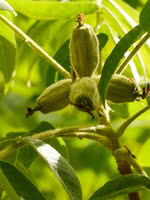Mon-Fri 9am - 5pm Mountain time
Horse Chestnut vs Butternut (White Walnut)
Aesculus hippocastanum
Juglans cinerea
CUSTOM GROW
Horse Chestnut is a medium sized deciduous tree that is native to Greece but has been grown in North America for hundreds of years. It produces large nuts.
A top CO2 absorbing species. Experts think this tree may help climate change more than others.
Butternut is one of the few walnut varieties native to Canada. The nuts are sought after for their mild, sweet, and oily taste. Ensure this tree is planted in full sun and well-drained soil for best results.
Butternut is self-fertile but it has better yields when planted near other butternuts. It can survive in zone 2, but reliably produces nuts in zone 3.
A top CO2 absorbing species. Experts think this tree may help climate change more than others.
Horse Chestnut Quick Facts
Butternut (White Walnut) Quick Facts
Toxicity: most parts of plant are toxic

